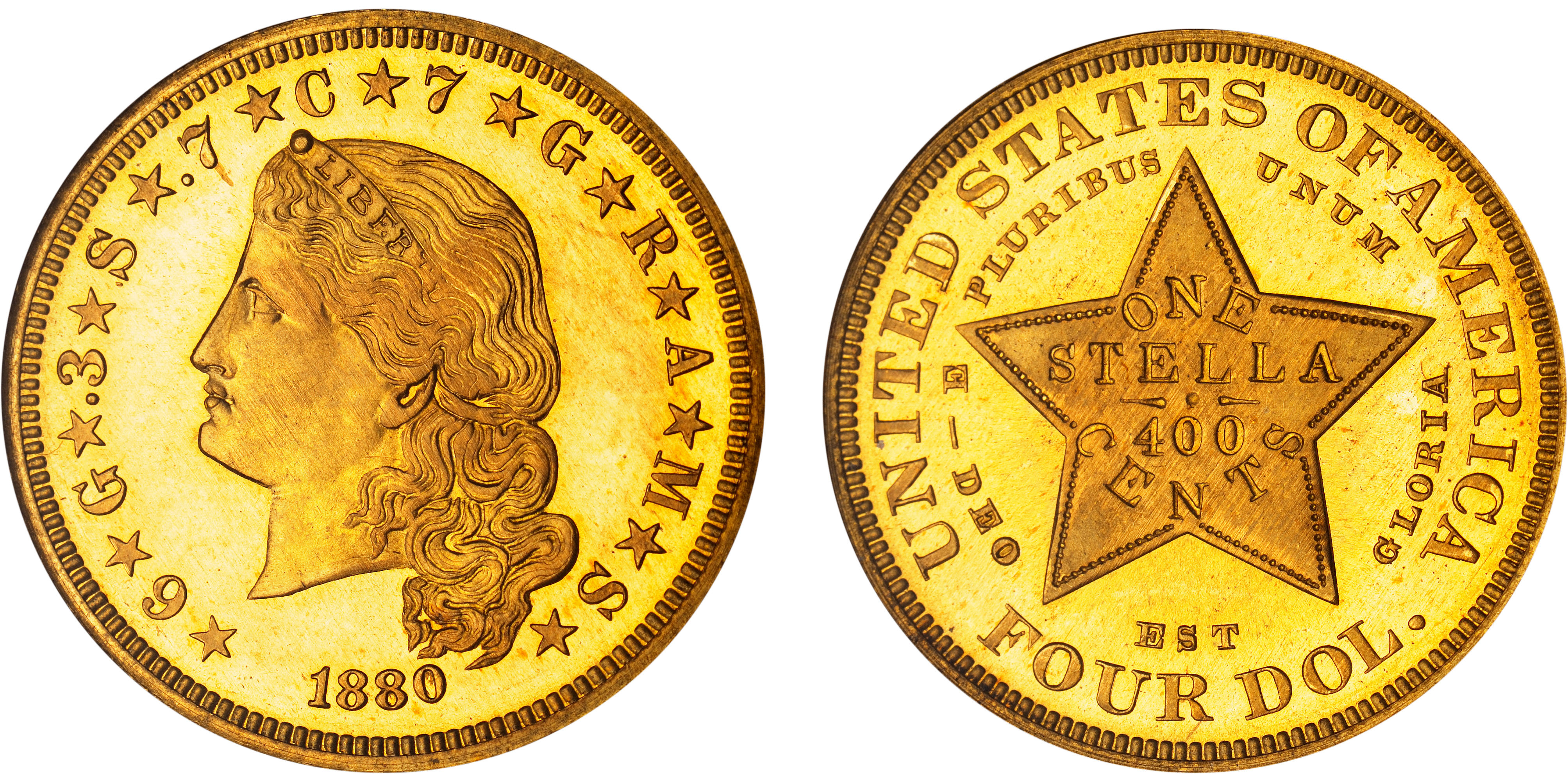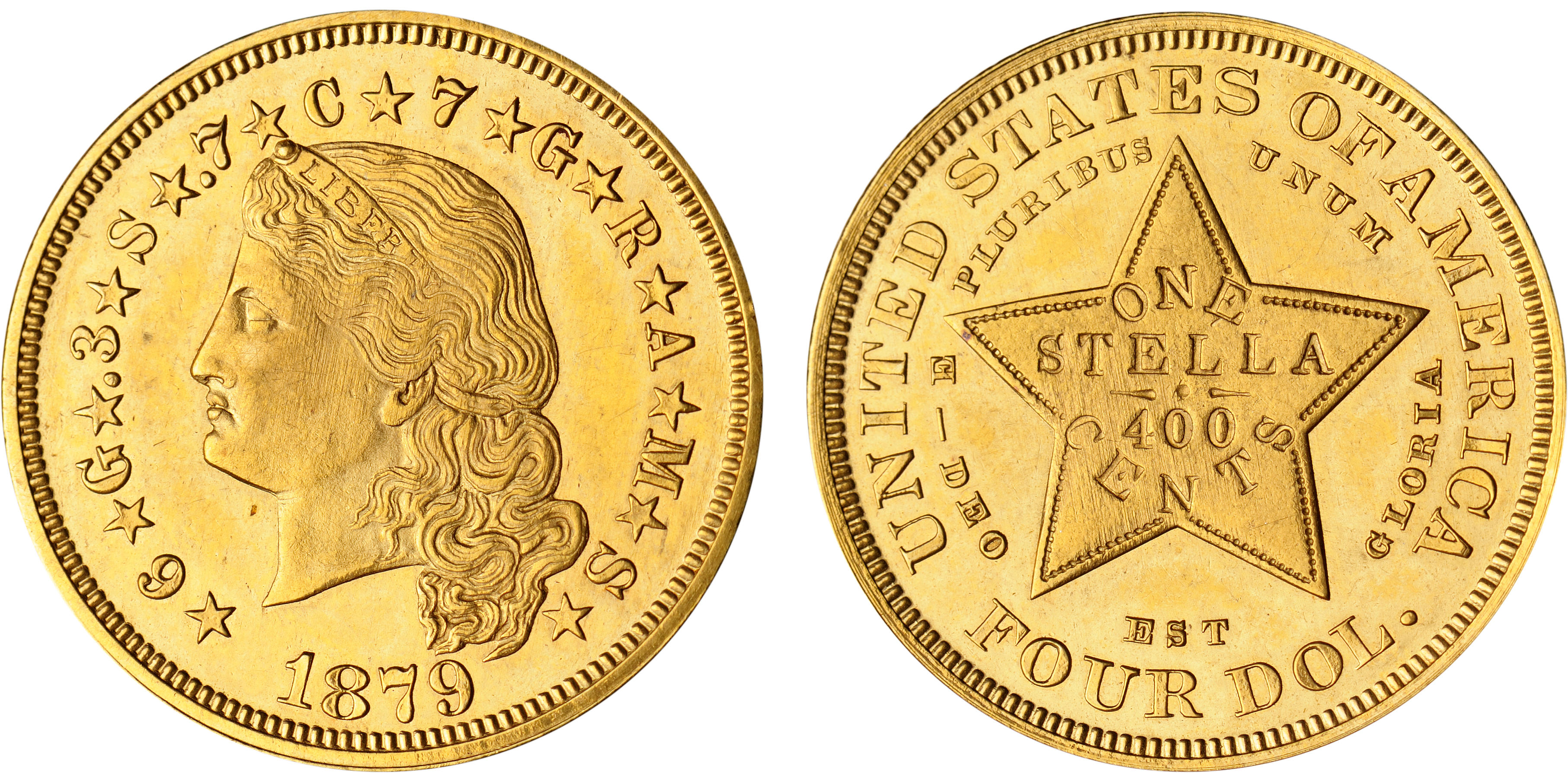Charles E. Barber designer Obverse: Head of Liberty facing left, wearing diadem inscribed LIBERTY, her hair flowing in long locks; around, ★6★G★.3★S★.7★C★7★G★R★A★M★S★; below, 1879. Reverse: Large five-pointed star inscribed in incuse: ONE / STELLA / — / 400 / CENTS, in five lines; around outer rim: UNITED STATES OF AMERICA — FOUR DOL.; around, within outer legend: E – PLURIBUS – UNUM — DEO – EST – GLORIA. Condition: NGC Proof 67 Cameo (Certificate number: 1963260-001 – Photo Proof 10-07; previous Photo Proof 04-05 [number: 115855-001]). A pale golden hue, with a faint milky cloudiness over superbly frosted devices which contrast starkly against the mirrored fields. Two tiny impressions on Liberty's neck and small marks at the top of the star serve as identifiers of this exceptional example. References: Judd 1635; Pollock 1832; Breen (Encyclopedia) 6407/6408; Breen (Proofs) p.164; Akers (1976) pp. 80-81; Akers (Patterns) p. 51, 103-104; Garrett and Guth (Encyclopedia) p. 170; Garrett and Guth, 100 Greatest U.S. Coins. (PCGS 88057) Condition Census: One of the finest known. NGC records ten coins as Proof 67 Cameo including three bearing the star designation (as well as two Ultra Cameo), and a single coin graded Proof 68. (When the earlier Photo Proof for this specimen was prepared in April 2005 [see above], NGC noted only six examples of equal grade to the presently offered coin, and nothing finer was cited). PCGS records four examples as Proof 67 Cameo, and one Deep Cameo. (07-13) Rarity: Very rare. Although 15 originals and 425 official restrikes were reportedly produced, a substantial number were used as jewelry or pocket pieces. Determining the difference between originals (which are supposed to be un-striated) and restrikes has confounded numismatists for years. As noted from the above census the number of Superb Gem quality Flowing Hair Stellas is remarkably small with only a dozen or so of the quality of this example. According to the PCGS data base of Auction Prices, this example when sold at auction in January 2005 realized, by a substantial margin, a record amount for the variety and was, at that time, included among the 250 all-time top auction prices for U.S. coins as recorded in the 2007 edition of A Guide Book of United States Coins [The Red Book], and it was still on the list in the 2009 edition. Provenance: Gold Rush Collection, Heritage, January 12, 2005, lot 30042, Proof 67 Cameo NGC, "a simply glorious specimen... magnificent." ($310,500) Note: Although the Stella is undoubtedly America's best known physical manifestation of an international currency, the idea of coinages which were of equivalent value and convertible in other countries was not new. According to a recent article, in 1855 Professor John H. Alexander published a pamphlet on an international coinage for the United States and Great Britain. The concept was to have the sovereign and half eagle of equal gold content and value. The idea reached the halls of Congress, which subsidized an exploratory trip to Great Britain for the professor, but following Alexander's report the program failed to win support. In Europe, the Latin Union was formed in 1865 and seven countries agreed to adopt the French currency system. The members of the Union would produce coins of a national character, but their value and underlying gold content would be based on the French franc. In Paris, two years later at an International Monetary Conference it was agreed (in principal) that all conferees would adopt a similar system, but in subsequent debates the system, largely on nationalistic grounds, was defeated. France's defeat in the Franco-Prussian War ended enthusiasm for the idea until 1878, when a second conference was held, again in Paris, at the urging of the United States. This time it was an international bimetallic standard that was proposed and it was as a result of this second conference that the Stellas were developed, largely at the urging of John Kasson, the Un
Charles E. Barber designer Obverse: Head of Liberty facing left, wearing diadem inscribed LIBERTY, her hair flowing in long locks; around, ★6★G★.3★S★.7★C★7★G★R★A★M★S★; below, 1879. Reverse: Large five-pointed star inscribed in incuse: ONE / STELLA / — / 400 / CENTS, in five lines; around outer rim: UNITED STATES OF AMERICA — FOUR DOL.; around, within outer legend: E – PLURIBUS – UNUM — DEO – EST – GLORIA. Condition: NGC Proof 67 Cameo (Certificate number: 1963260-001 – Photo Proof 10-07; previous Photo Proof 04-05 [number: 115855-001]). A pale golden hue, with a faint milky cloudiness over superbly frosted devices which contrast starkly against the mirrored fields. Two tiny impressions on Liberty's neck and small marks at the top of the star serve as identifiers of this exceptional example. References: Judd 1635; Pollock 1832; Breen (Encyclopedia) 6407/6408; Breen (Proofs) p.164; Akers (1976) pp. 80-81; Akers (Patterns) p. 51, 103-104; Garrett and Guth (Encyclopedia) p. 170; Garrett and Guth, 100 Greatest U.S. Coins. (PCGS 88057) Condition Census: One of the finest known. NGC records ten coins as Proof 67 Cameo including three bearing the star designation (as well as two Ultra Cameo), and a single coin graded Proof 68. (When the earlier Photo Proof for this specimen was prepared in April 2005 [see above], NGC noted only six examples of equal grade to the presently offered coin, and nothing finer was cited). PCGS records four examples as Proof 67 Cameo, and one Deep Cameo. (07-13) Rarity: Very rare. Although 15 originals and 425 official restrikes were reportedly produced, a substantial number were used as jewelry or pocket pieces. Determining the difference between originals (which are supposed to be un-striated) and restrikes has confounded numismatists for years. As noted from the above census the number of Superb Gem quality Flowing Hair Stellas is remarkably small with only a dozen or so of the quality of this example. According to the PCGS data base of Auction Prices, this example when sold at auction in January 2005 realized, by a substantial margin, a record amount for the variety and was, at that time, included among the 250 all-time top auction prices for U.S. coins as recorded in the 2007 edition of A Guide Book of United States Coins [The Red Book], and it was still on the list in the 2009 edition. Provenance: Gold Rush Collection, Heritage, January 12, 2005, lot 30042, Proof 67 Cameo NGC, "a simply glorious specimen... magnificent." ($310,500) Note: Although the Stella is undoubtedly America's best known physical manifestation of an international currency, the idea of coinages which were of equivalent value and convertible in other countries was not new. According to a recent article, in 1855 Professor John H. Alexander published a pamphlet on an international coinage for the United States and Great Britain. The concept was to have the sovereign and half eagle of equal gold content and value. The idea reached the halls of Congress, which subsidized an exploratory trip to Great Britain for the professor, but following Alexander's report the program failed to win support. In Europe, the Latin Union was formed in 1865 and seven countries agreed to adopt the French currency system. The members of the Union would produce coins of a national character, but their value and underlying gold content would be based on the French franc. In Paris, two years later at an International Monetary Conference it was agreed (in principal) that all conferees would adopt a similar system, but in subsequent debates the system, largely on nationalistic grounds, was defeated. France's defeat in the Franco-Prussian War ended enthusiasm for the idea until 1878, when a second conference was held, again in Paris, at the urging of the United States. This time it was an international bimetallic standard that was proposed and it was as a result of this second conference that the Stellas were developed, largely at the urging of John Kasson, the Un








Try LotSearch and its premium features for 7 days - without any costs!
Be notified automatically about new items in upcoming auctions.
Create an alert